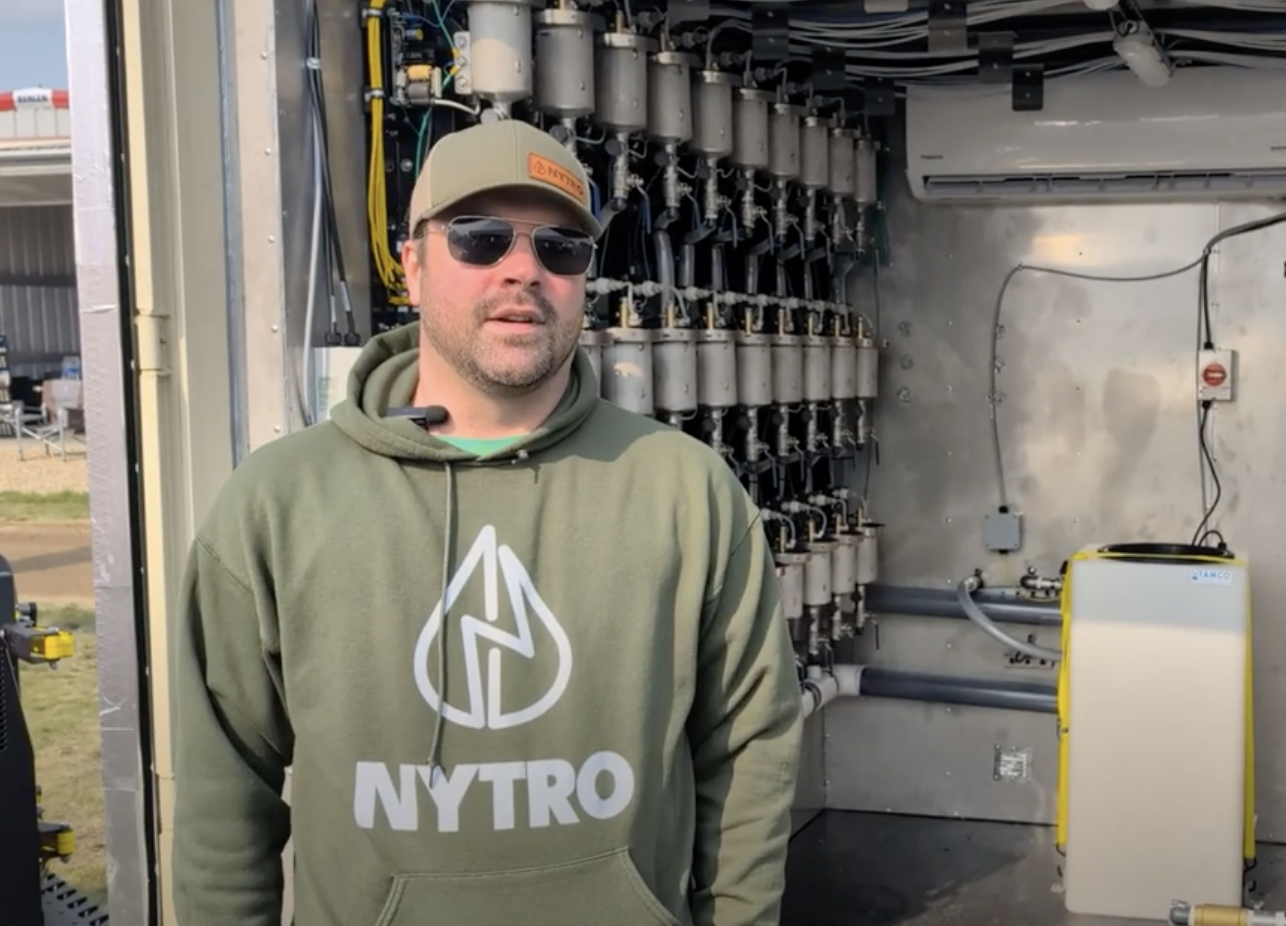AS OF THIS spring, you and me and the guy across the road with the Chevy half-ton can buy the same upgraded, bulletproof 6.5-litre diesel now being installed in all U.S. military Humvees, old and new.
“I would guess that Uncle Sam didn’t want his Humvees breaking down on Saddam’s doorstep,” says Doug Watson of Western Turbo and Fuel Injection in Winnipeg. “But that’s just my guess. So instead of changing out to a whole new engine line for the Humvee and going through their whole fleet with a big re-fit program, they decided to reinvest in the old 6.2/6.5 and make it more reliable. This new engine is an exact bolt-in replacement for the old one.”
Read Also

VIDEO: Green Lightning and Nytro Ag win sustainability innovation award
Nytro Ag Corp and Green Lightning recieved an innovation award at Ag in Motion 2025 for the Green Lightning Nitrogen Machine, which converts atmospheric nitrogen into a plant-usable form.
The upgraded engine, called the Optimizer 6500, is manufactured by AM General Corporation in Franklin, Ohio. It can replace any 6.2-litre or 6.5-litre diesel engine that went into General Motors C/K and P series trucks from 1982 through 2000. And it’s the required bolt-in replacement diesel for all US military Humvees built since 1985 that were originally fitted with the GM 6.2-litre and 6.5-litre diesels.
GM brought out its 6.2-litre diesel in 1982. Ten years later, it bored it out to 6.5 litres. By 2001, that engine was replaced by a totally different one, the 6.6-litre Duramax, which is a joint project with Isuzu. On the outside, the re-engineered Optimizer 6500 engine from AM General looks the same as the old. Inside, it’s a different story.
The new engine has been re-engineered to eliminate the cracking that occurred in the main bearing saddle area and the cylinder head bolt boss area.
The material incorporates nickel and molybdenum alloys that give the casting 25 percent more strength throughout. The new design features main bearing caps that are taller and wider, along with a stronger head bolt boss.
Internal piston oil spray passages within the block now have thicker walls. These oil passages on the original engines were larger than they needed to be, and were fitted with a small nozzle to spray the underside of the pistons. Large diameter oil passages meant the block casting material was thinner in those areas.
The new cylinder heads have better cooling passages and hardened valve seats. Previous problems were never traced to crankshaft or connecting rod failure, so the Optimizer 6500 is designed to accept the older style crankshaft and connecting rods.
“Another change is that they went to full timing gears instead of half chain and half gears,” adds Watson. AM General says the machining tolerances on the new engine are more accurate than on the ancestral 6.2 and 6.5 engines.
One of the best features is the price. “It’s only $6,800 Canadian for a new long block with new heads. That’s an exchange price. The Optimizer engine has a remanufactured crankshaft and connecting rods. Everything else on the unit is new. Now we have an engine for GM light trucks that should last as long as a Cummins or a Powerstroke,” Watson says.
“We’re surprised that we still see so many of these 6.2/6.5 engines coming in for rebuild,” adds Percy Hofs of Diesel Services Group in Saskatoon. “We typically see seven or more of these engines in here per week. That includes the ones we get from Alberta and Manitoba. “
Hofs admits that, like others in the rebuild industry, his firm has had limited success trying to rebuild with the original style block.
“You could flip a coin to determine whether you saw that engine back in here again. On the rebuilds we do here ourselves in Saskatoon, we install a stud girdle kit that bolts to the bottom end and tries to hold everything together. Just like a girdle, really,” says Hofs.
“That solved the bottom end problem. It actually prevents the lower part of the block from cracking. But, it’s like the weakest link in a chain. Once the bottoms were OK, we got the top end of the block cracking where the cylinder bolts go into the block.
“We’re also a supplier and warehouse for a Minnesota company called Reviva. We’ve had much better results with their modified blocks than with any of the original General Motors blocks.”
Hofs says his firm has sold about 50 of the new Optimizer 6500 within the past three months. A customer should not expect more horsepower or torque from the Optimizer, just a more durable engine that will match the life expectancy of the truck.
Back at Western Turbo, Watson praises the units.
“The GM truck itself is excellent. The truck was never the problem. It just had those weak spots in the block and the heads. There are so many of these trucks on the used market because of engine failure. This new engine is going to breathe new life into thousands and thousands of trucks.
“What we’ve seen over the past 20 some years is that if a farmer wanted a real hard working truck, he bought Dodge or Ford, because those diesels could do the work without breaking. If you wanted a nice grocery truck with diesel power, you’d buy Chevy.
“You know, a lot of our customers are farmers, and right now they’re telling me, ‘man, we’re so glad to hear that somebody is finally doing something about those engines.'”
George Stringam of Taber Diesel in Taber AB is another person who did something about the engines. Stringam, who runs an independent diesel shop, has done his share of engine building.
“I was with GM for a number of years, back when we had the 5.7-litre diesels,” says the mechanic. An avid reader of various motor racing magazines, Stringam says there have been numerous remedies over the years to the age-old problem of bottom end failure. None of those remedies permanently cured an engine that had problems on the design table.
“The old 409-cubic-inch Chevy is one good example of a powerful engine that could easily hatch the bottom end. It badly needed help. Some of the early hot rodders put on straps that bolted to the block and held the main caps up in place. And there were solid cast oil pans that put pressure upwards on the main caps to keep things from flexing.”
Stringam says these add-on fixes have merit but they never cure a bad design.
“On those General Motors diesels, I think we’ve found a pretty good solution to the problem, without having to redesign the whole engine. There’s a company in Minneapolis, Minnesota called Reviva, and they actually modify the 6.2/6.5 core blocks to make them stronger. It’s not just a line bore,” says Stringam.
“They put the main cap bolts in from an angle instead of straight up. That spreads the load out over a bigger area. They do a lot of work on the block to reinforce it, and their engines seem to last a long time. I’d say they’re the best rebuilder we’ve dealt with yet.”
While most diesel rebuilders seem to think every 6.2/6.5 out there is a candidate for at least one major overhaul, Stringam has a different opinion.
“Quite honestly, and I know a lot of people will disagree with me on this point, but I’m not convinced those 6.2/6.5 engines are really as bad as some people seem to think. The U.S. Army runs them 1,500 hours in their Humvees. At that point, even if it’s running perfectly, they pull the engine and stick in a new one. But, you know, that’s a lot of hours to beat up an engine.”
Contact: Doug Watson 204-632-1366
George Stringam 403-223-9636
Percy Hofs 800-667-6879















